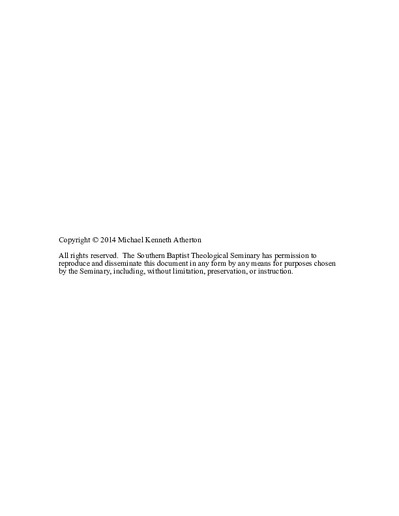Shared Leadership as Exemplified by the Apostle Paul
Abstract
SHARED LEADERSHIP AS EXEMPLIFIED
BY THE APOSTLE PAUL
Michael Kenneth Atherton, Ed.D.
The Southern Baptist Theological Seminary, 2014
Chair: Dr. Michael S. Wilder
This thesis studies the presence and role of shared leadership as displayed through the ministry of the apostle Paul. In chapter 1, the reader will come to understand that there are no comprehensive works dealing with the discipline of shared leadership by Paul. However, when one comes to accept the presence of shared leadership through the Scriptures, there is an expectation that one will practice the discipline (Jas 1:22-25).
Chapter 2 explores the literature base to gain an appreciation for what scholarship has offered as it relates to shared leadership. It can be argued that lack of literature to discuss shared leadership is ultimately the result of a vernacular disconnect. Nevertheless, it is incumbent upon this study to discriminate and establish a working definition for the discipline of shared leadership and to explore Paul's view of the church
Perhaps the greatest metaphor used by Paul to describe the church is his reference to the church being the representation of the body of Christ. Chapter 3 examines Paul's view of leadership in the church, beginning with a functional understanding of Paul's ecclesiology. In addition, Paul's view of spiritual giftedness in the life of a believer will be examined, as one's giftedness is critically important to understanding Paul's view of shared leadership.
Chapter 4 examines Paul's philosophy and practice of shared leadership by looking at six principles throughout the Pauline corpus: (1) functioning within one's giftedness, (2) deference, (3) Paul's team based ministry approach, (4) Paul's vernacular, (5) Paul's partnerships, and (6) Paul's instructions to church leaders.
Chapter 5 begins by exploring the benefits of shared leadership. Five benefits are considered: shared responsibility, accountability, unity, collaboration, and shared vision. It is contended that these benefits have a direct result on an organization's competence and effectiveness. In addition, chapter 5 explores best practices of shared leadership, contributions to the precedent literature, and relevant prospects for future study.

